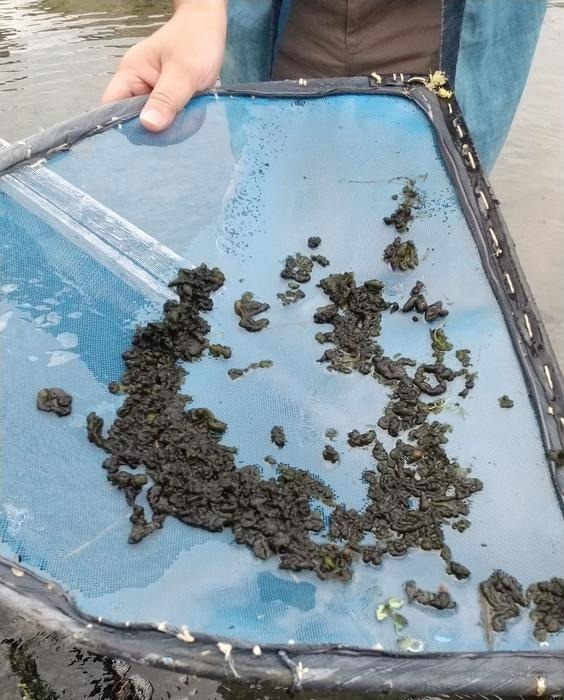As the cosmetics business moves toward a more sustainable future, natural substitutes for chemical agents used in products are becoming more popular. Through intensive bioprospecting research, scientists are looking for active substances found in nature to use in skincare products. In this sense, cyanobacteria are a viable source of these drugs due to their exceptional metabolic capability.
 Researchers from Japan and Thailand have discovered that the cyanobacterium A. sacrum (Suizenji Nori in Japanese) produces two types of saclipins under drought stress. The compounds have UV-absorbing, antioxidative, and antiglycative capacities and could be used as environmentally friendly ingredients in skincare products. Image Credit: Hakuto Kageyama
Researchers from Japan and Thailand have discovered that the cyanobacterium A. sacrum (Suizenji Nori in Japanese) produces two types of saclipins under drought stress. The compounds have UV-absorbing, antioxidative, and antiglycative capacities and could be used as environmentally friendly ingredients in skincare products. Image Credit: Hakuto Kageyama
These photosynthetic organisms have been on Earth for around 3.5 billion years, and they have evolved to a variety of settings, including harsh ones. The ability of the cyanobacterium Aphanothece sacrum, which is native to Japan and is grown on farms in Fukuoka Prefecture as a food source, to create active components like sacran, a polysaccharide that retains water, is already being researched.
Researchers led by Professor Hakuto Kageyama of Meijo University in Japan have identified two distinctive compounds generated by A. sacrum, called saclipin A and saclipin B.
When the two types of saclipins were accidentally discovered, the researchers were initially assessing environmental stress tolerance mechanisms in cyanobacteria and investigating whether A. sacrum contained mycosporine-like amino acids (MAAs), which can absorb UV radiation and have antioxidative and antiglycative properties.
Presently, most UV-absorbing ingredients are chemically synthesized. They pose a significant environmental risk and can inhibit the growth of organisms like seaweed and corals. Natural ingredients will go a long way in improving the environmental credentials of cosmetics and pharmaceuticals as industries pursue ways to be more environmentally conscious.”
Hakuto Kageyama, Professor, Meijo University
The findings of the research team were published in the Journal of Agricultural and Food Chemistry.
The scientists needed to separate the cyanobacterial compounds from A. sacrum cells for them to examine them. First, the researchers made an organic extract of dried A. sacrum and looked for UV-absorbing compounds in it.
They then purified target metabolites with absorption spectra close to 320 nm, a wavelength within the UV light bandwidth. Finally, the chemical structure of the purified compounds was determined using mass spectroscopy and nuclear magnetic resonance.
“Structurally, the saclipins were completely different from known UV-absorbing compounds derived from cyanobacteria, such as MAAs and scytonemin. They absorbed UV radiation, scavenged damaging oxygen free radicals, and inhibited the glycation of collagen and elastin. Taken together, these characteristics show they have the potential to slow down aging,” Kageyama added.
The scientists discovered that drought stress increased saclipin production by subjecting A. sacrum to several environmental stressors to understand the growth circumstances that promoted its synthesis.
They also discovered a novel feature of saclipins: photoisomerization. Under fluorescent light irradiation, saclipin A might be transformed into saclipin B. This trait is important because it enables rapid modification of saclipin ratios in product formulations based on intended usage.
Kageyama stated, “A. sacrum is cultivated as a food source in Japan. If we can understand how to produce the saclipins at scale, there is the potential to develop them as an edible anti-aging supplement.”
He hopes that more studies will focus on the protection of this freshwater cyanobacterium.
He concluded, “Such findings could serve as the catalyst for broader conservation efforts. Sustainable aquaculture production could go a long way to securing A. sacrum’s future.”
Source:
Journal reference:
Uchida, Y., et al. (2023). Identification of Desiccation Stress-Inducible Antioxidative and Antiglycative Ultraviolet-Absorbing Oxylipins, Saclipin A and Saclipin B, in an Edible Cyanobacterium Aphanothece sacrum. Journal of Agricultural and Food Chemistry. doi.org/10.1021/acs.jafc.3c05152